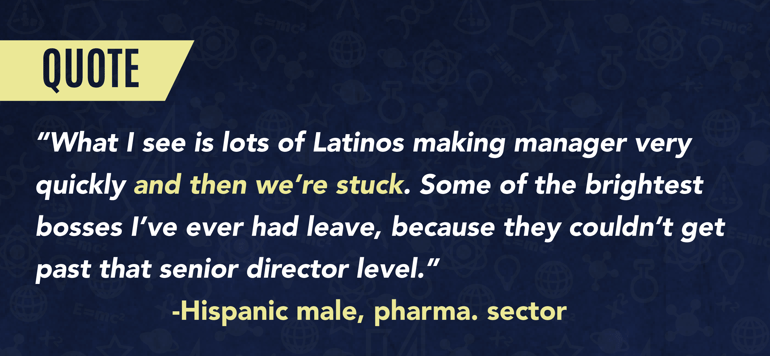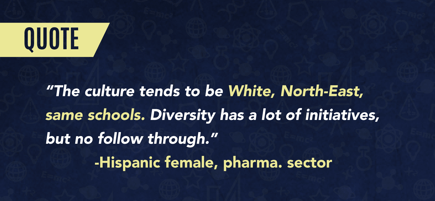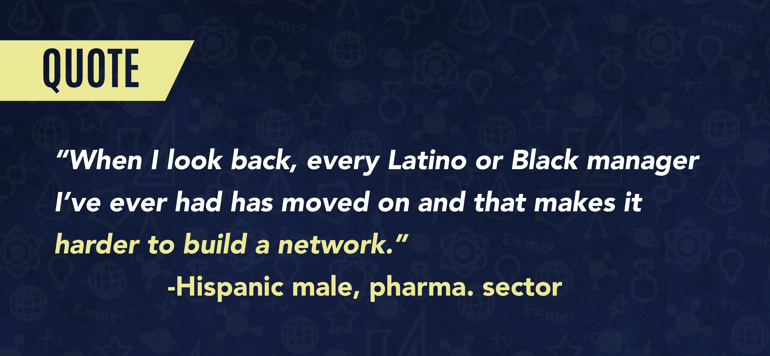According to the U.S. Bureau of Labor Statistics, growth in STEM fields are expected to outpace overall employment growth in the economy.[1] Recent research has shown that due to this rapid growth, there is a large gap between available STEM jobs and available skilled workers to fill them. Concurrently, about 18 percent of the U.S. population is of Hispanic descent, with this number expected to increase to 28 percent by 2060.[2] [3] While many industries have made strides in Hispanic representation, STEM-related industries continue to struggle in recruiting and retaining Hispanic talent. With this in mind, the Hispanic Association on Corporate Responsibility (HACR) set out to understand the barriers that limit the inclusion and professional progression of Hispanic STEM professionals. We are pleased to announce the publication of the 2019 HACR STEM Report, a culmination of several years of research and interviews. Through the insights shared in this report, HACR outlines the strategic actions needed to enhance the recruitment, career development, and advancement opportunities for Hispanics in STEM.
Research shows that negative self-perceptions, and an under-resourced education system, follow Hispanics into their professional careers, thereby slowing their career progression and advancement into leadership positions as compared to their White male counterparts.[4] This stagnation results in a “leaky pipeline,” whereby Hispanic STEM talent then seeks employment in other fields. HACR interviewed more than 30 Hispanic STEM professionals to gain insight as to what factors they felt were impacting their career progression and causing this “leaky pipeline”.
 Among the top contributing factors to the “leaky pipeline” were corporate culture, in-group bias, perceptual bias, and a lack of professional role models. Our study participants reported feeling that their organizations were entrenched in a culture dominated by white-males. They reported these cultures as not being objective meritocracies, but isolating and self-reinforcing environments. In-group bias, the tendency to favor members of one’s own group over those in other groups, further contributes to these isolating and self-reinforcing cultures by amplifying the exclusion of Hispanics from internal networks. Exclusion from these internal networks decreases their opportunity to access organizational information and impedes their ability to establish strategic alliances. All these elements ultimately work together to limit their visibility among senior managers.
Among the top contributing factors to the “leaky pipeline” were corporate culture, in-group bias, perceptual bias, and a lack of professional role models. Our study participants reported feeling that their organizations were entrenched in a culture dominated by white-males. They reported these cultures as not being objective meritocracies, but isolating and self-reinforcing environments. In-group bias, the tendency to favor members of one’s own group over those in other groups, further contributes to these isolating and self-reinforcing cultures by amplifying the exclusion of Hispanics from internal networks. Exclusion from these internal networks decreases their opportunity to access organizational information and impedes their ability to establish strategic alliances. All these elements ultimately work together to limit their visibility among senior managers.
 Visibility among management can also be hindered by perceptual biases. Perceptual bias can manifest in the workplace through selective hiring and/or favoritism based on things like age, name, gender, and skin tone. These perceptual biases, combined with their lack of visibility and feelings of alienation, further impedes Hispanic STEM professionals’ ability to advance to more senior leadership roles. The lack of Hispanics in corporate leadership roles is itself a problem, as many Hispanic professionals report struggling to see themselves as leaders due to not seeing other Hispanics as leaders. To ensure their long-term economic growth and development, companies, especially those in STEM, must address the factors that contribute to their “leaky pipeline” of Hispanic talent.
Visibility among management can also be hindered by perceptual biases. Perceptual bias can manifest in the workplace through selective hiring and/or favoritism based on things like age, name, gender, and skin tone. These perceptual biases, combined with their lack of visibility and feelings of alienation, further impedes Hispanic STEM professionals’ ability to advance to more senior leadership roles. The lack of Hispanics in corporate leadership roles is itself a problem, as many Hispanic professionals report struggling to see themselves as leaders due to not seeing other Hispanics as leaders. To ensure their long-term economic growth and development, companies, especially those in STEM, must address the factors that contribute to their “leaky pipeline” of Hispanic talent.
MOVING FORWARD
Although Hispanics remain underrepresented in STEM fields, there are things companies can do to become more inclusive workplaces for Hispanic talent. The direct involvement of the CEO and company leadership in diversity and inclusion efforts can help set the tone for the rest of the organization. This can include things like promoting events, holding diversity reviews and trainings, and holding managers and executives accountable for achieving diversity initiatives. Leadership development programs can also help funnel a broader diversity of talent into leadership roles. More diverse leadership can in turn help create active and effective champions and role models.
The reality is that as long as companies fail to meet the unique needs of different employee populations, they will continue to fail to create meaningful opportunities for Hispanics to develop and contribute fully. The future will continue to rely on technological and scientific innovation and these innovations do not arise on their own. Diversity is critical to innovation, and unless those fields become diverse in thought and talent, companies will struggle to maintain a capable workforce and remain competitive. The cultivation of excellence across the social spectrum is therefore in every company’s long-term best interest.
 To learn more, download a copy of the 2019 HACR STEM Report here.
To learn more, download a copy of the 2019 HACR STEM Report here.

.png?width=1900&height=470&name=HRI%20Blog%20Post%20Template%20Banner%20(1900x470).png)


Share Your Thoughts with Us.
Comment below.